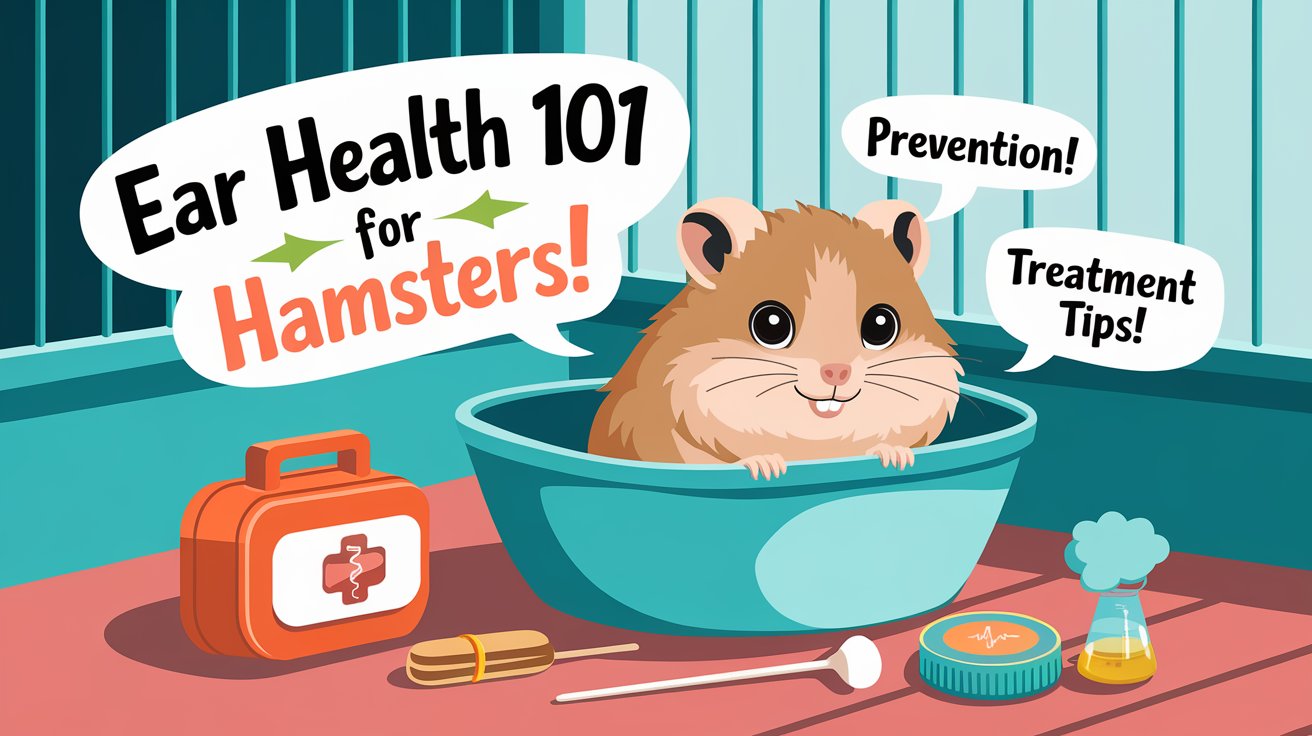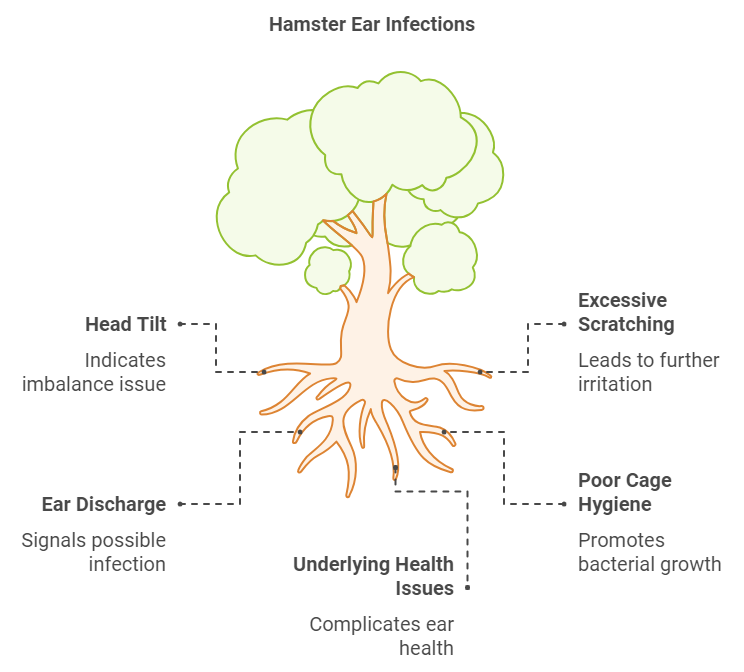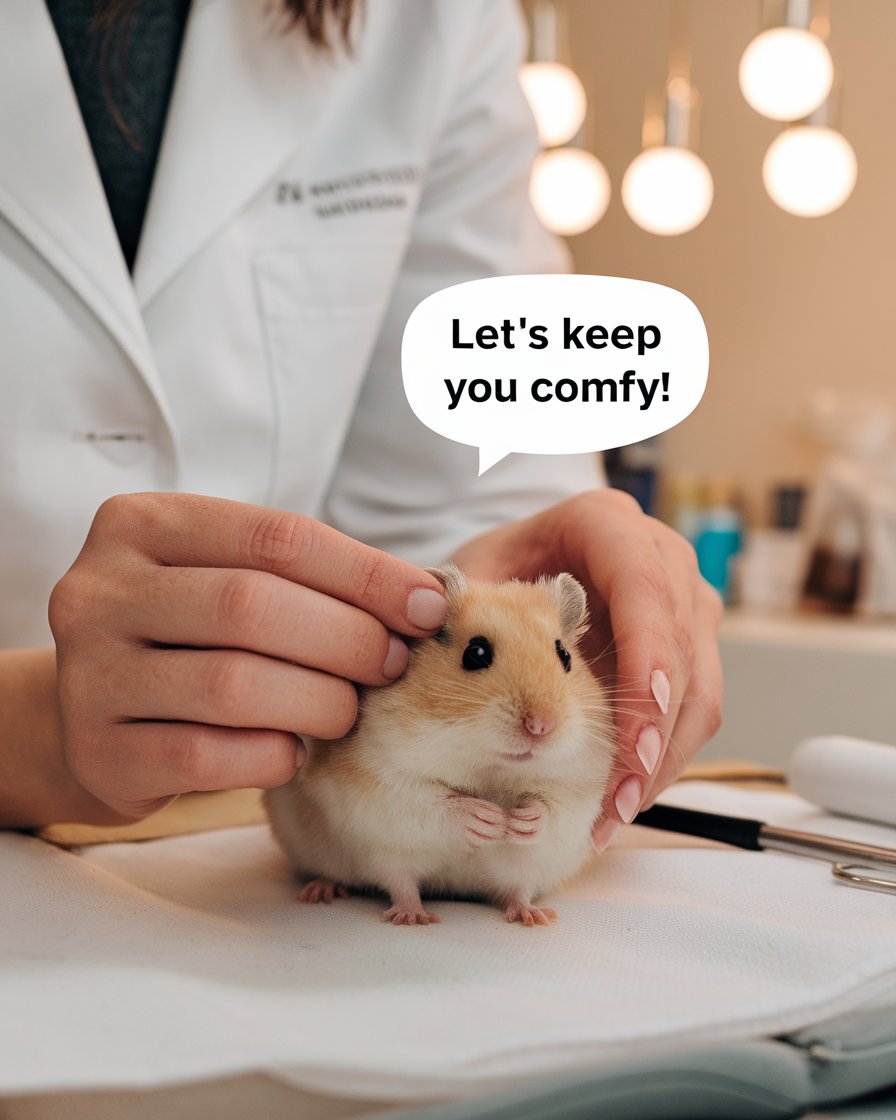Introduction
Ear infections can be a significant health concern for hamsters, affecting their behavior and overall comfort. Recognizing the symptoms early—such as head tilting, frequent scratching, and circling behavior—can be crucial for timely treatment. These infections often stem from bacterial or fungal growth within the ear canal, sometimes worsened by unsanitary cage conditions or other health issues. Prompt attention to these signs, along with a visit to a vet, can prevent further complications and restore your pet’s well-being quickly. Ensuring your hamster’s ears stay healthy begins with understanding the symptoms and causes.
For hamster owners, knowing how to manage these infections at home while maintaining proactive hygiene practices is essential. Simple actions like cleaning the cage regularly, conducting routine ear inspections, and following prescribed treatments can make a considerable difference. Additionally, for hamsters prone to chronic infections, establishing a long-term care plan with guidance from a veterinarian can help control symptoms and improve quality of life. By staying attentive to early signs and consistently managing your hamster’s environment, you can reduce the risk of ear infections and support a healthier, happier pet.
Key Takeaways
- Recognizing early symptoms like head tilting, scratching, and circling can help address ear infections before they worsen.
- Timely veterinary care is essential for accurate diagnosis and effective treatment of hamster ear infections.
- Home remedies, such as applying a small amount of Vaseline, can provide relief for minor ear issues when used cautiously.
- Maintaining a clean cage environment is crucial to prevent bacterial buildup and reduce the risk of infections.
- Routine ear checks enable hamster owners to catch early signs of discomfort and seek prompt care.
- For chronic infections, a consistent care plan with veterinary guidance helps manage symptoms and ensures a better quality of life for the hamster.
Understanding Hamster Ear Infections
Hamsters are susceptible to ear infections, which can significantly impact their well-being if left untreated. Key symptoms to look out for include head tilting, frequent circling, or persistent scratching near the ears. Observant owners may also notice ear discharge or debris, signaling potential infection. Recognizing these symptoms early allows for prompt action, reducing the risk of severe complications. Left untreated, infections can lead to more serious issues, such as chronic pain or hearing loss. Seeking veterinary advice as soon as symptoms arise is crucial. Professionals can accurately diagnose and prescribe treatments suited to the hamster’s specific needs, ensuring a faster recovery and a return to normal behavior. Understanding these symptoms is the first step in maintaining your hamster’s ear health.
Recognizing Symptoms of Ear Infections in Hamsters
Hamsters can display a variety of symptoms when an ear infection is present. Some key indicators include excessive scratching near the ears, head tilting, and circling behavior. You might also notice a discharge or buildup of debris in the ear canal, which could be a sign of an underlying infection. These symptoms suggest that your hamster is in discomfort and requires attention. Recognizing these early signs is vital in preventing further complications. If these symptoms are observed, consult a veterinarian promptly to discuss appropriate treatments. Timely intervention can help reduce pain and avoid any long-term damage, ensuring that your hamster stays healthy and comfortable.
Causes of Ear Infections in Hamsters
Ear infections in hamsters can result from a range of factors, including bacterial or fungal growth, cage hygiene issues, or underlying health problems like respiratory infections. Unsanitary cage conditions may lead to bacterial buildup, increasing the chances of an ear infection. Occasionally, yeast infections or other fungal issues can also cause discomfort in the ear canal, resulting in pain and inflammation. In some cases, neurological issues can lead to similar symptoms, such as head tilting or circling. Identifying the root cause is essential for effective treatment, so consulting a veterinarian is recommended for accurate diagnosis and advice.
Common Signs and Causes of Hamster Ear Infections
1. Head Tilting and Circling
One of the most recognizable signs of a potential ear infection in hamsters is a head tilt or circular walking pattern. These symptoms suggest an imbalance issue, often related to ear health, and require immediate attention from a vet.
2. Excessive Ear Scratching and Irritation
Frequent scratching at the ears can indicate discomfort and possibly an infection. Persistent scratching may exacerbate the issue, leading to further irritation or secondary infections in the area.
3. Ear Discharge or Debris Build-up
Visible discharge or debris in the ear canal is another common symptom of an infection. This can include yellowish or brownish material, signaling a possible bacterial or fungal presence that needs to be addressed.
4. Causes Linked to Cage Hygiene
Unsanitary cage conditions can promote bacterial or fungal growth, increasing the likelihood of infections. Regular cage cleaning minimizes this risk, keeping the hamster’s environment healthier overall.
5. Underlying Health Issues
Other health conditions, such as respiratory infections, can sometimes contribute to ear problems. If a hamster shows signs of general illness, it’s wise to have a comprehensive veterinary evaluation.
Immediate Steps for Treating Hamster Ear Infections at Home
When an ear infection is suspected, there are simple, safe steps that can provide immediate relief while awaiting veterinary assistance. For dry or flaky skin around the ears, applying a small dab of Vaseline using a cotton swab may soothe discomfort. It’s essential to use a light touch and avoid over-application, as hamsters have sensitive skin. If antibiotics are recommended, administering them as instructed by a veterinarian is key to treating the infection properly. Pain relief might also be prescribed to help alleviate any discomfort during recovery. Monitoring the hamster’s response to treatment and maintaining a clean environment can further support healing and prevent the spread of infection. With careful, gentle home care, owners can assist in their pet’s healing process effectively.
Safe Application of Home Remedies
When using home remedies, it’s essential to prioritize safety and avoid causing additional irritation. Applying a light coat of Vaseline to dry or flaky skin around the ears can be effective in soothing the area, but be cautious with the amount used. A gentle application with a cotton swab, followed by close monitoring, can help alleviate symptoms without aggravating the infection. If symptoms persist or worsen, it’s best to consult a veterinarian. Using home remedies mindfully provides some relief for minor issues but should never replace professional advice when symptoms are more severe.
Administering Antibiotics and Pain Relief
For diagnosed ear infections, veterinarians often prescribe antibiotics and sometimes pain relief medication. Administering these medications as per the veterinarian’s instructions is crucial to avoid any side effects. Antibiotics work to combat the infection directly, while pain relief can help reduce discomfort. Since hamsters are small, even minor dosage errors can have significant effects, so it’s vital to follow the dosage closely. Completing the full course of antibiotics ensures effective treatment and lowers the risk of recurrence. Adhering to the vet’s guidance during this process greatly enhances the chances of a smooth recovery for your hamster.
Case Study: Long-Term Management of Chronic Ear Infections in Hamsters
Sarah, a dedicated hamster owner, noticed her pet, Muffin, frequently tilting his head and scratching his ears. Concerned about these behaviors, she promptly scheduled a vet appointment, where Muffin was diagnosed with an ear infection. After a successful initial treatment involving prescribed antibiotics and pain relief, Sarah maintained close contact with her veterinarian, who recommended a proactive care routine due to Muffin’s susceptibility to recurring infections.
Following her vet’s guidance, Sarah developed a long-term plan that included bi-weekly ear checks, cage sanitation, and regular follow-ups. She also monitored Muffin’s behavior closely, watching for any signs of discomfort or relapse. This approach not only prevented further complications but also allowed Muffin to enjoy a stable, healthier life despite his chronic condition. Sarah’s dedication to consistent care showcases how early intervention and preventive measures are vital for pets prone to chronic health issues.
Prevention Techniques to Avoid Ear Infections in Hamsters
Maintaining a clean and well-organized habitat is one of the most effective ways to prevent ear infections in hamsters. Regularly cleaning the cage and washing accessories, such as food dishes and toys, help reduce bacteria buildup. Providing fresh bedding and promptly removing waste minimizes the risk of infections and keeps the hamster’s environment hygienic. Additionally, routine ear inspections allow owners to detect signs of infection early on, such as unusual head tilting or scratching behaviors. Proactively monitoring your hamster’s health through frequent checks and maintaining cage hygiene not only helps prevent ear infections but also promotes overall well-being. Keeping the hamster’s living conditions sanitary is an effective, preventive approach for a healthier, happier pet.
Importance of Routine Cage Cleaning
Keeping your hamster’s cage clean is essential for their overall health and to prevent ear infections. Regular cleaning of the cage and all accessories, such as food bowls and wheels, helps prevent bacteria and debris buildup. Ideally, the cage should be cleaned weekly, with daily spot cleaning for waste removal. Fresh bedding should also be added regularly to keep the environment comfortable and hygienic. By reducing bacteria levels in the cage, you’re helping to prevent infections and promoting a healthier, happier environment for your hamster.
Checking for Early Signs of Infection
Incorporating regular ear checks into your hamster care routine is an excellent way to detect issues before they escalate. Look for behaviors like head tilting, frequent scratching, or an increase in debris around the ears. Gently inspect the ears without causing stress to your pet, and monitor for signs like discharge or swelling. By conducting these checks, you’ll be able to catch infections early, when they’re easier to treat. Consistent observation helps ensure that any health problems are promptly addressed, maintaining your hamster’s overall well-being.
The greatness of a nation and its moral progress can be judged by the way its animals are treated. — Mahatma Gandhi
Managing Chronic Ear Infections in Hamsters
For hamsters with recurring ear infections, a long-term management plan is essential. Chronic infections require regular veterinary check-ups and consistent care to avoid further complications. Veterinary guidance can help owners implement effective treatments, including the careful use of prescribed antibiotics and pain relief as needed. Regular cleaning of the ears under vet supervision and close monitoring for signs of recurring infection, such as behavioral changes or head tilting, are critical. In chronic cases, maintaining a routine and following the vet’s advice can greatly improve the hamster’s quality of life. With attentive care and a proactive approach, managing chronic ear infections becomes a feasible task, allowing hamsters to lead more comfortable lives despite their condition.
Establishing a Long-Term Care Plan
For hamsters with recurring ear infections, a comprehensive care plan can make a significant difference in managing their health. This plan typically includes regular veterinary check-ups, careful administration of medications, and periodic ear cleanings if recommended by the vet. By staying consistent with treatments, owners can help reduce the frequency and severity of infections. Creating a schedule for follow-ups and treatments supports the hamster’s ongoing recovery and minimizes discomfort. With a reliable long-term plan, it’s possible to maintain a higher quality of life for hamsters facing chronic ear issues.
Recognizing Behavioral Indicators of Discomfort
Hamsters often exhibit subtle signs of discomfort when dealing with chronic ear infections, such as changes in activity levels, altered sleeping patterns, or signs of irritability. Observing these behavioral changes can provide insight into the hamster’s health. Frequent head tilting, circling, or restlessness are red flags that should not be overlooked. By staying attuned to these signs, owners can take timely action, whether by consulting the veterinarian or adjusting treatment strategies. Monitoring behavior is a key aspect of managing chronic conditions effectively, helping to ensure the hamster’s comfort and health.
Conclusion
Caring for a hamster’s ear health is an essential part of pet ownership, as untreated ear infections can lead to discomfort and potentially serious complications. By recognizing early symptoms like head tilting, circling, and excessive scratching, hamster owners can quickly take steps to prevent further issues. Regular check-ups with a vet, along with home care methods such as gentle ear cleaning and maintaining a clean cage, are vital in preventing infections. Following these proactive measures can help your hamster avoid common ear-related issues and enjoy better overall health.
For hamsters with chronic ear infections, consistent care and a structured management plan are key. Long-term treatments prescribed by a veterinarian, combined with regular monitoring of behavior and routine cage hygiene, provide a comprehensive approach to managing these persistent issues. By staying vigilant and prioritizing their pet’s ear health, hamster owners can ensure that their furry companions remain happy and comfortable. With a balanced approach of prevention and timely intervention, you can support your hamster’s well-being and give them the best quality of life possible.

















